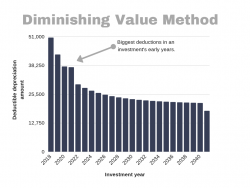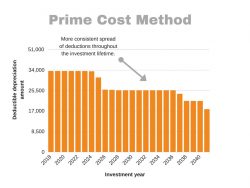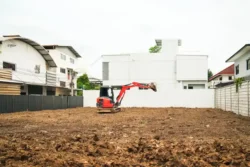Commercial property depreciation is a gift for investors
Published
July 23, 2019
Published
July 23, 2019

Commercial property depreciation is the ageing of commercial real estate assets and fixtures over time. The decrease in value of things like Plant and Equipment and even the building itself can be used to reduce your taxable income. Depreciation is effectively a value-add for commercial property investors.
Yet “80 per cent of property investors don’t claim depreciation because they don’t know what it is.” Whether the figure is true, the statement makes a good point. Most property investors haven’t accepted one of their biggest tools to fix tax bills is depreciation.
The lack of knowledge is particularly true for foreign investors in Australia – new to our shores and new to investing in the second most transparent real estate market in the globe.
Here we cover three questions which will help Australian property investors appreciate their depreciation gift:
- What can be used as depreciation in commercial property?
- How is depreciation used as a tax deduction?
- How does depreciation in Australia compare to other countries?
[Note: This article only scratches the surface of depreciation. For specific, individual advice on depreciation consult a qualified tax expert.]
What can be used as commercial property depreciation?
Plant and Equipment
Like businesses looking at how their expenses can be used as tax deductions (from cost of a new crane to amount paid for a new stapler), commercial property owners need to be alert when checking for depreciable items.
So, they should look inside the building.
Many small, removable items owned by the landlord can be added to the depreciation schedule, like:
- Desks, shelves, etc (belonging to the landlord)
- Air conditioning units
- Carpet
- Security systems
- New fit-outs
The loss of value over time can be used to claim deductions against taxable income.

To find plant and equipment that can be used as depreciation deductions, look inside the building.
Capital Allowances (the building itself)
The ageing of a commercial property investment can be claimed as a depreciation deduction. And this is deductible over a period of 40 years from the building’s construction date, being the accepted lifespan of a building.
Capital allowances should make up the bulk of a commercial property’s yearly total deduction.
How is depreciation deducted?
Australian property investors have two options when using depreciation as a tax deduction – “aggressive” upfront claims vs. a more consistent claim each year:
Diminishing Value Method (or Diminishing Returns Method) – “Aggressive”
Investors using the diminishing value depreciation method will see a much larger depreciation amount in the early years of their investment. It’s the hard-hitting approach to reducing a property’s first few tax bills.
But what does ‘diminishing’ mean? Well, depreciation on plant decreases in value every year, so claims drop each year until the asset value ‘runs out’.

Our above graph shows the first claim years have a huge depreciable amount for this investor. But in the following ten years the annual deductible depreciation amount is nearly halved.
This is by no means a bad thing.
For example, an investor may have significant taxable income in the early years of their investment and may want to offset this early investment income with a large depreciation claim.
Prime Cost Method (or Straight-Line Method) – “Consistent”
This is the technique for investors wanting a more consistent depreciation deduction each year.
A landlord who receives less rental income in the investment’s early years might benefit from this approach. The property could have vacancies which will be filled later or maybe the landlord forecasts the local rental market to improve in the coming years.

So, instead of large annual depreciation sums in an investment’s early years (i.e. Diminishing Value Method), deductions can be spread consistently each year – seen in the graph above.
At the end of the day, both methods result in the same total amount of deprecation. So, which to use depends on what is most appropriate for a particular investment.
For more information on how the DMV and Prime Cost methods calculate the amount of depreciation claims, consult a tax expert or visit the ATO website.
How does depreciation in other countries compare?
It’s not the same for everyone though. Other countries have unflattering rules for depreciation claims, which is a possible reason for foreign investors accounting for a large portion of property ownership on our shores.
So, how does depreciation in other countries compare to Australia’s?
South Africa – No depreciation (except in some locations)
Investors of South African property can’t use depreciation like investors in Australia. And unless a property is located in a particular region, they don’t apply depreciation at all.
South Africa provides domestic investors with accelerated depreciation (where an asset loses book value at a faster rate than the traditional straight-line method) but only in Urban Development Zones. These zones can have accelerated depreciation applied. But outside these areas depreciation is not used as a tax deduction in South Africa.
China – Limited depreciation
Investors of Chinese real estate are only allowed to use the Straight-Line Method. Aggressive reductions in taxable rental income is unavailable as there is no option to use the Diminishing Value Method.
Depreciation is also only applicable for 20 years – not 40 years like in Australia.
USA – Limited depreciation
Like China, the US only uses the Straight-Line Method, which spreads depreciation values equally over a property’s lifetime. And the deduction is only allowed for 20 years. Australian tax law lets investors deduct depreciation for twice as long, and landlords also have the option of aggressive deductions with the Diminishing Value Method.
Depreciation is crucial for investors who are trying to mitigate capital gains tax. Wholesale investors in particular are usually faced with huge tax bills at the end of the financial year. So why not use the ATO’s gift and deduct the depreciable value of your commercial property investment.
For more information on how you can invest in a commercial real estate syndicate, get in touch with Properties & Pathways.






